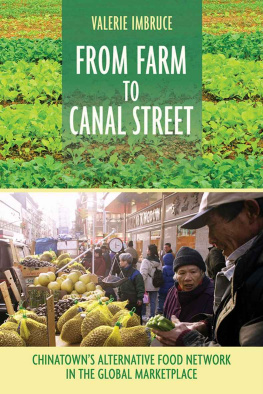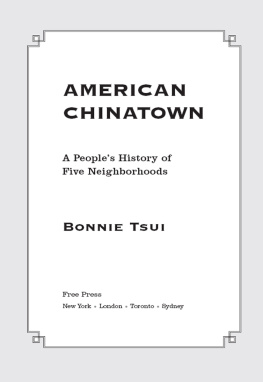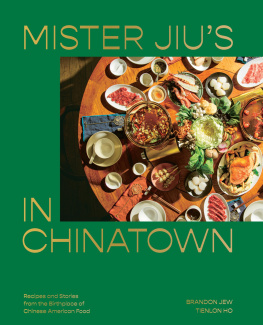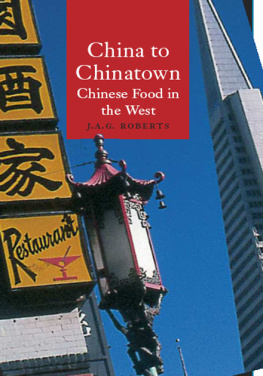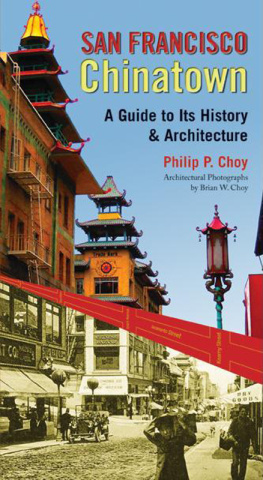From Farm to Canal Street
CHINATOWNS ALTERNATIVE FOOD NETWORK IN THE GLOBAL MARKETPLACE
VALERIE IMBRUCE
Cornell University Press
Ithaca and London
To Kevin,
for your support
CONTENTS
PREFACE
N ew York City, like many American cities, is in the midst of an agricultural awakening. Farmers markets, community gardens, farm-to-chef collaborations, and urban agriculture are popular and financially successful. New Yorkers are taking more of a personal stake in how their food is grown and city officials are considering how they can sustain their agricultural hinterlands. For a city that once ruthlessly devoured its market gardens in Brooklyn and Queens at the turn of the twentieth century to make way for a growing urban population, it seems that now, one hundred years later, New Yorkers are thinking more carefully about their food supply.
Since its early colonial days, New York has never been an isolated state. It was a colony built on trade. Meat, lard, and grains from the New York environs made their way from New York Harbor to the British plantations of the Caribbean in exchange for sugar. Throughout the nineteenth century, canals and rails connected the eastern port city to the interior and the south of the United States, and Manhattan imported much of its food supply. The steady stream of immigrants from the mid-1800s on contributed to a rapid urbanization of the greater New York region and to the decline of agriculture.
One of the smaller groups of immigrants of the late 1800s, the Chinese, began provisioning their own foods. The Chinese enclave in Manhattan grew in population throughout the 1900s to become the largest concentration of Chinese immigrants in the United States. Today Manhattans Chinatown remains iconic of New Yorks immigration history. It is also an iconic food destination, where tourists and New Yorkers alike go to eat and shop. There is no other marketplace like it in New York City. What is less known about Chinatown is its food system. At a moment in time when more and more people are interested in how food is produced and distributed, there are many questions to ask about Chinatowns food system. This marketplace is strikingly different from that of the average supermarket and the myriad fruits and vegetables sold here are not sold anywhere else in the city. Where does all the food come from and how does it get here? Is there something fundamentally different about the way that Chinatowns produce is grown and supplied? What are the livelihoods and rural transitions associated with agricultural bounty for sale in Chinatowns markets?
This book tells the untold stories of how the food system of New Yorks oldest and most famous ethnic enclave has developed. I consider how Chinatowns food network continues to operate amid the citywide push to centralize food distribution and the nationwide trend in the vertical integration of food production, processing, and retail that have transformed the way that food is grown and sold. I describe how the street-level produce markets of Chinatown have survived in the wake of the consolidation of the grocery retail sector and the citys removal of pushcart and wholesale produce vendors; how and why farmers from New York, Florida, and Honduras choose to grow niche Asian fruits and vegetables that carry no price premiums and have no mainstream market; and how risk-taking entrepreneurs orchestrate a dynamic and flexible global network of trade without the use of mergers and acquisitions to keep Chinatowns shelves bountiful.
C HINATOWN may be a unique ethnic enclave, but it is by no means isolated. Chinatown is part of the global economy. Produce markets in Chinatown have no doubt been shaped by free trade and liberalized American immigration policies that characterize global economic integration. Yet Chinatowns produce markets also display characteristics that are alternative, or contradictory, to globalization. The retail and wholesale sectors are small and fragmented. The wholesale, not retail, sector sets prices. Asian immigrants and their descendants continue to consume ethnic foods, resisting acculturation and the mainstreaming of Asian diets into American ones. Chinese food in New Yorks Chinese restaurants continues to change with shifting immigration trends from China and urban trends in eating, reflecting current tastes and ideas about dining.
Chinatowns agricultural reach is also global in scope. The purchasing power of the areas shoppers provides livelihoods to small and large farmers struggling to stay afloat in the United States as well as in less developed nations. But instead of fostering monocropping and one industry-wide style of farming, the farms that grow Chinatowns produce use crop diversity and other practices that reflect cultural and biophysical specificity. Chinese vegetable growers in the United States today, with few exceptions, are members of multigenerational and new immigrant families who choose to grow and sell the ethnic foods of their people. The styles of agriculture that immigrant farmers bring from their homelands are often overlooked in discussions of food and agriculture, again seen as operative in spite of global capitalism instead of a viable economic form in themselves. The Honduran farmers that are part of Chinatowns food system are very much in need of good market opportunities. They report that Asian vegetables are the most stable market they can participate in. They have made small steps in improving their relations with export firms without explicit labor organization or the formation of grower cooperatives.
The way that Chinatown procures food demonstrates another kind of globalization, one that does not threaten regional agricultural economies, is not homogenizing cultures, and is not controlled by mega corporations. Rather, Chinatowns food system embodies a global economic network that is constructed by people who may have been marginalized but instead are carving out their own global niche in an economic network based in the cultural and biological specificities of the people and places involved. Although this particular network may persist only as long as Asian immigrants keep coming to the United States and eating diets filled with tropical, subtropical, and temperate fruits and vegetables, it is an adaptable model that connects farmers to market, one that can persist within the highly dynamic global environment.
The story of Chinatowns food network is one of interdependence between the local and global, the rural and urban realms. If we take local and urban in this story to be synonymous as representative terms for New York Citybased produce markets, then these particular Asian markets dont conform to theories about other local, urban markets. Chinatown markets are dependent on neither a social movement, such as the push for local food, nor the quality turn in local markets that enables the price premiums garnered in farmers markets or for organically certified foods. Unlike other markets for local food, there are no political dictates about which farmers can participate in Chinatowns markets (dictates such as New York Citys Greenmarket programs definition of the radius in which farmers must live). New York Citybased produce wholesalers set prices and quality standards but display flexibility in their relations with farmers. Thus it becomes the will of the farmer (the rural dweller) as much as the will of the produce broker (the urban dweller) to define this spatial relationship.
There are lessons that can be drawn from Chinatowns food system that have significance for urban planning and politics. Ethnic neighborhoods should be analyzed for the means by which they provide culturally specific foods to their residents. It may seem novel that today New Yorkers are claiming more and more of a stake not just in purchasing and consuming food but in procuring and producing it as well. Chinatown residents have been doing this since they formed their Manhattan enclave in the 1800s. I would hypothesize that the development of culturally specific food networks are integral to the formation of immigrant neighborhoods. New York City celebrates its ethnic restaurants; why not learn how they are maintained? In Chinatown, the decentralization of produce distribution and the proximity of food-related businesses, from produce wholesalers to restaurant menu printers, are vital to the success of Chinatowns food industry cluster. Policies that support upscale real estate development and centralization of wholesale food distribution threaten Chinatowns vibrant food economy.
Next page
